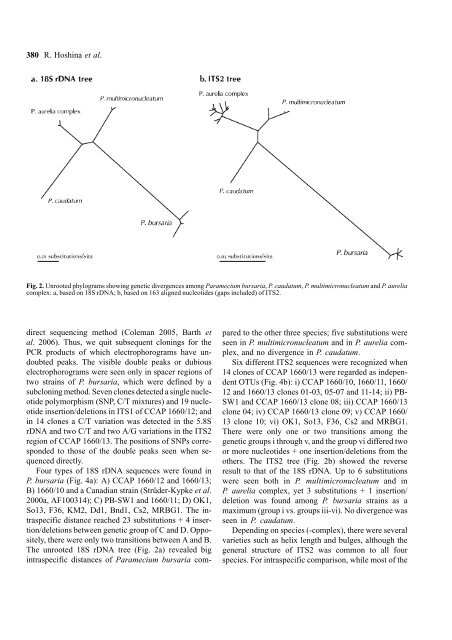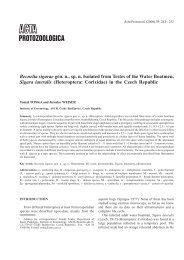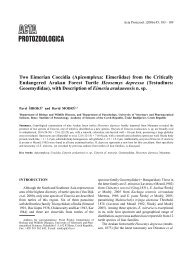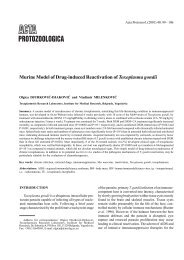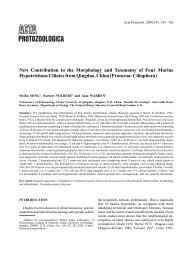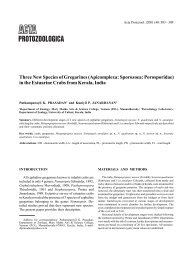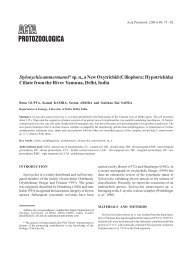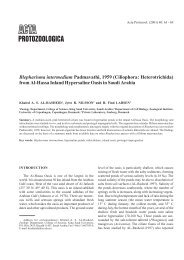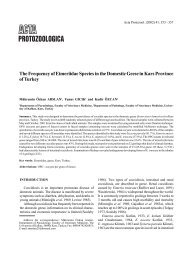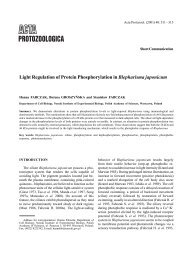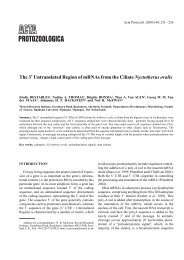Intraspecific Genetic Divergence of Paramecium ... - CiteSeerX
Intraspecific Genetic Divergence of Paramecium ... - CiteSeerX
Intraspecific Genetic Divergence of Paramecium ... - CiteSeerX
You also want an ePaper? Increase the reach of your titles
YUMPU automatically turns print PDFs into web optimized ePapers that Google loves.
380 R. Hoshina et al.<br />
Fig. 2. Unrooted phylograms showing genetic divergences among <strong>Paramecium</strong> bursaria, P. caudatum, P. multimicronucleatum and P. aurelia<br />
complex: a, based on 18S rDNA; b, based on 163 aligned nucleotides (gaps included) <strong>of</strong> ITS2.<br />
direct sequencing method (Coleman 2005, Barth et<br />
al. 2006). Thus, we quit subsequent clonings for the<br />
PCR products <strong>of</strong> which electrophorograms have undoubted<br />
peaks. The visible double peaks or dubious<br />
electrophorograms were seen only in spacer regions <strong>of</strong><br />
two strains <strong>of</strong> P. bursaria, which were defined by a<br />
subcloning method. Seven clones detected a single nucleotide<br />
polymorphism (SNP, C/T mixtures) and 19 nucleotide<br />
insertion/deletions in ITS1 <strong>of</strong> CCAP 1660/12; and<br />
in 14 clones a C/T variation was detected in the 5.8S<br />
rDNA and two C/T and two A/G variations in the ITS2<br />
region <strong>of</strong> CCAP 1660/13. The positions <strong>of</strong> SNPs corresponded<br />
to those <strong>of</strong> the double peaks seen when sequenced<br />
directly.<br />
Four types <strong>of</strong> 18S rDNA sequences were found in<br />
P. bursaria (Fig. 4a): A) CCAP 1660/12 and 1660/13;<br />
B) 1660/10 and a Canadian strain (Strüder-Kypke et al.<br />
2000a, AF100314); C) PB-SW1 and 1660/11; D) OK1,<br />
So13, F36, KM2, Dd1, Bnd1, Cs2, MRBG1. The intraspecific<br />
distance reached 23 substitutions + 4 insertion/deletions<br />
between genetic group <strong>of</strong> C and D. Oppositely,<br />
there were only two transitions between A and B.<br />
The unrooted 18S rDNA tree (Fig. 2a) revealed big<br />
intraspecific distances <strong>of</strong> <strong>Paramecium</strong> bursaria compared<br />
to the other three species; five substitutions were<br />
seen in P. multimicronucleatum and in P. aurelia complex,<br />
and no divergence in P. caudatum.<br />
Six different ITS2 sequences were recognized when<br />
14 clones <strong>of</strong> CCAP 1660/13 were regarded as independent<br />
OTUs (Fig. 4b): i) CCAP 1660/10, 1660/11, 1660/<br />
12 and 1660/13 clones 01-03, 05-07 and 11-14; ii) PB-<br />
SW1 and CCAP 1660/13 clone 08; iii) CCAP 1660/13<br />
clone 04; iv) CCAP 1660/13 clone 09; v) CCAP 1660/<br />
13 clone 10; vi) OK1, So13, F36, Cs2 and MRBG1.<br />
There were only one or two transitions among the<br />
genetic groups i through v, and the group vi differed two<br />
or more nucleotides + one insertion/deletions from the<br />
others. The ITS2 tree (Fig. 2b) showed the reverse<br />
result to that <strong>of</strong> the 18S rDNA. Up to 6 substitutions<br />
were seen both in P. multimicronucleatum and in<br />
P. aurelia complex, yet 3 substitutions + 1 insertion/<br />
deletion was found among P. bursaria strains as a<br />
maximum (group i vs. groups iii-vi). No divergence was<br />
seen in P. caudatum.<br />
Depending on species (-complex), there were several<br />
varieties such as helix length and bulges, although the<br />
general structure <strong>of</strong> ITS2 was common to all four<br />
species. For intraspecific comparison, while most <strong>of</strong> the


